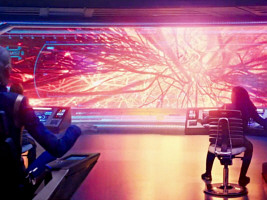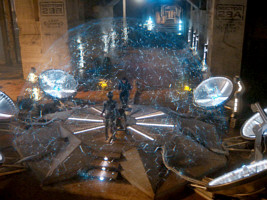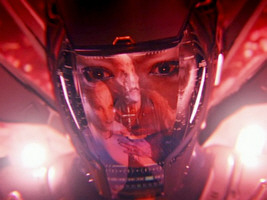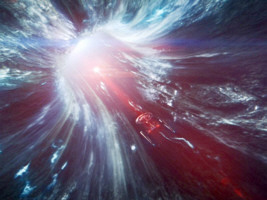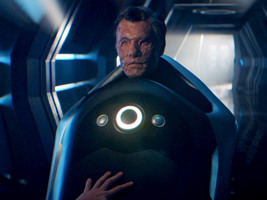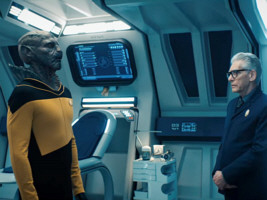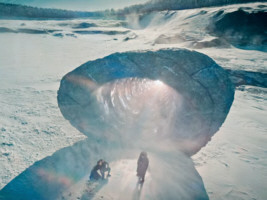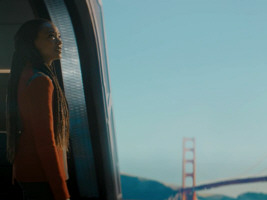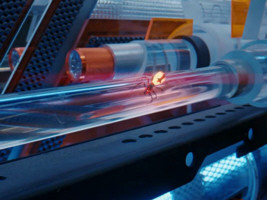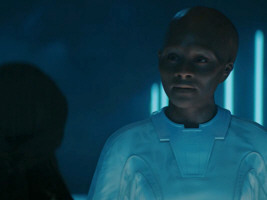Time Travel in Star Trek: Discovery (DIS)
"People think time is fragile. Precious. Beautiful. Sand in an hourglass, all that. But it's not. Time is savage. It always wins." (Dr. Burnham, DIS: "Perpetual Infinity")
DIS: Magic to Make the Sanest Man Go Mad
 A time crystal gives Harry Mudd the ability to rewind time by 30 minutes, with him being the only one who is aware of the effect. Everyone else experiences those 30 minutes without noticing that everything happens again and again. Using this tactical advantage, Harry Mudd gradually learns to evade his pursuers and to operate the systems of the Discovery with the goal of handing the ship over to the Klingons. Lt. Stamets is the only other person who knows what is going on, thanks to his connection to the spore network. It takes at least 56 loops for Stamets and his crew to stop Mudd.
A time crystal gives Harry Mudd the ability to rewind time by 30 minutes, with him being the only one who is aware of the effect. Everyone else experiences those 30 minutes without noticing that everything happens again and again. Using this tactical advantage, Harry Mudd gradually learns to evade his pursuers and to operate the systems of the Discovery with the goal of handing the ship over to the Klingons. Lt. Stamets is the only other person who knows what is going on, thanks to his connection to the spore network. It takes at least 56 loops for Stamets and his crew to stop Mudd.
The idea behind this story is very similar as that of TNG: "Cause and Effect". The difference in a physical and logical sense is that in the TNG episode time was reset in a causality loop, which may have lasted forever without human interference. In the Discovery episode, Mudd triggers the reset on purpose in each loop (or it is triggered by his death). There is no causality loop in "Magic to Make the Sanest Man Go Mad" but "only" someone playing with the "time controls".
It is clear that Mudd's crystal does not reset time in the whole galaxy or universe but just in a limited space around the Discovery. He wears a wrist device that seems to control the time displacements and obviously protects him against the effect. The displacement is triggered by Mudd pressing a button or by his death as it seems. The actual crystal is located in his ship that is hidden inside the Gormagander. This readily explains why it is necessary each time for him to get the "space whale" aboard the Discovery in order to pursue his plan, although he might have found better ways once he knew all controls of the ship he wants to capture. Yet, it also aggravates the problem of why the creature was beamed aboard each time, although Stamets knew what was going on. Had he managed to convince Lorca not to do it in just one of the many loops, Mudd may not have been able to carry on.
Classification: time reset in an isolated region of space-time
DIS: What's Past Is Prologue
After the escape from the Mirror Universe through the spore network the USS Discovery arrives in its own universe nine months late. It is not the first time that the time is a variable in the crossover from one universe to another. Something similar already happened in ENT: "In a Mirror, Darkly", except that the USS Defiant of our universe crossed over in the opposite direction, and wound up in the past of the Mirror Universe.
Classification: travel to the future of another universe
Red Angel arc
The time travel arc related to the Red Angel spans the whole second season of the show. Particularly interesting observations can be made in the following episodes:
- DIS: "Brother": Seven red lights appear simultaneously all over the galaxy, a phenomenon that, among other possible reasons, may be a sign of a temporal anomaly. There is no evidence of a time travel yet. A "new" signal (#1, actually one of the seven that reappears) leads the Discovery to an asteroid field where the crew rescues Jett Reno from the crashed USS Hiawatha and harvests dark matter. Michael Burnham sees the Red Angel for the first time.
- DIS: "New Eden": It turns out that Spock, in some kind of premonition, sketched up the signals before they appeared. When another "new" signal shows up (#2), it leads the Discovery to a remote planet named Terralysium with human settlements. Their ancestors were rescued by a winged entity from WWIII, some 200 years ago. The Discovery can avert a planetary disaster, pulling away debris from the orbit using the gravity of the dark matter asteroid. The Red Angel does not appear in person to anyone.
- DIS: "An Obol for Charon": An ancient sphere shows up in Discovery's flight path and transfers its complete database to the Starfleet ship. At the time this happens, the encounter is rated as accidental, and not yet as a time-travel-related event.
- DIS: "The Sound of Thunder": A third signal (#3) leads the Discovery to Kaminar, Saru's homeworld. A crisis arises when the Ba'ul capture Saru, who is considered dangerous because of his "evolution". Pike eventually decides to trigger that "evolution" in the complete Kelpien population. The Red Angel appears to Saru and his sister. Saru later muses that the Red Angel is a time traveler, as evidenced by the simultaneous appearance of red signals in different parts of the galaxy, by the tachyon residue and by the exosuit using a yet unknown technology.
- DIS: "Light and Shadows": This episode has the first on-screen evidence of time travels related to the Red Angel. Here, the appearance of the Red Angel leaves behind a temporal anomaly that the Discovery investigates. We can see a few "temporal hiccups" similar to the ones in TNG: "We'll Always Have Paris". Some of them are like echoes of events that already happened (such as Pike's discussion with Tyler on the bridge), some are flashforwards from the future (such as Pike's apparition of him shooting Tyler). The latter seems to indicate that the timeline is predetermined. Since it is not possible to control probes without being dangerously close to the anomaly, Pike and Tyler take a shuttle and launch a probe from there. The probe, however, reappears with upgrades that were done 500 years into the future. It is obvious that someone must have "abducted" the probe on purpose because it very unlikely that it would end up in the future by chance, and someone would decide to send it back just for fun.
- DIS: "If Memory Serves": It seems clear that the Red Angel is a time traveler, and Michael Burnham wonders why the entity would contact Spock, and if and how Spock could have a special perception of time. The Red Angel showed Spock the destruction of all sentient life in the galaxy in a possible future.
- DIS: "The Red Angel": At this point, the theory is that Michael Burnham is the Red Angel, and that she traveled through time in an attempt to keep Control, the AI built by Section 31, from evolving, which would otherwise lead Control to destroy all sentient life in the galaxy. The crew devises a plan to capture the Red Angel, using Michael Burnham as a bait and exposing her to the poisonous atmosphere of the planet Essof IV. If she herself is the Red Angel, she would have to come and save her life because of the grandfather paradox. The Red Angel appears and can be held in place using a forcefield. But it's not Michael Burnham. The Red Angel actually is her mother.
- DIS: "Perpetual Infinity": Dr. Gabrielle Burnham was thought to have been killed some 20 years ago, when Klingons raided her lab (and Michael was sure she heard them kill her), but she actually managed to power up the time travel suit she and her husband were building and escaped. Her plan was to travel 10 minutes to the past, but she ended up 950 years in the future. Gabrielle Burnham says that she didn't create the seven signals. However, she mentions that she visited her daughter several times in her life, usually without her noticing anything, and ensured that she would be safe. It was her who saved the people from WWIII and transferred them to Terralysium and who arranged for the Discovery to encounter the Sphere. She also witnessed the evolution of Control, and was determined to prevent it from happening. The key to the evolution, in her view, is the data that Discovery obtained from the ancient Sphere and that would become the decisive step in the AI's evolution. All of her attempts to erase the Sphere data were unsuccessful. It is also impossible to delete the data from Discovery's computer, so the crew attempt to transfer it to the time travel suit and send it to the future where it can do no harm, an attempt that Leland, meanwhile infected by Control's nanobots, thwarts. Gabrielle Burnham disappears to the future again, the suit is gone too, and the data is still in Discovery's computer.
- DIS: "Through the Valley of Shadows": A new signal (#4) leads the ship to Boreth, a Klingon planet where Pike is greeted by Tenavik, L'Rell and Voq's son. Tenavik is grown up because of the time anomalies on the planet. Pike asks for a time crystal to pursue the plan to send the Sphere data to the future, but this comes at the price of him witnessing his own inescapable future, that he will suffer severe radiation burns and end up in a wheelchair.
- DIS: "Such Sweet Sorrow I": The plan is to destroy the Discovery to get rid of the Sphere data, but the data has taken control of the ship, disables the auto-destruct and raises the shields. Another new signal (#5) pops up at Xahea, the home planet of Po, who has devised a method to recrystallize dilithium and who also comes up with an idea how to power the time crystal. As the time travel suit was specified to work only with her mother's DNA, Michael Burnham is the only person who could tow the ship into the future, which would be a one-way trip. Many of the Discovery crew agree to join her.
- DIS: "Such Sweet Sorrow II": Section 31 ships surround the Discovery and the Enterprise, while the crew completes the new time travel suit. Michael Burnham tries to enter the coordinates 930 years in the future, but it is not possible. In order to fulfill what has already happened, she first has to travel back in time and create the five signals that are already known. The timeline is predestined much like in TOS: "Assignment: Earth" and TNG: "Time's Arrow". She has to rescue Jett Reno to have her engineering expertise, she has to go to Terralysium to find a safe harbor, she has to change the society on Kaminar to have their support against Section 31, she has to get Pike to acquire the time crystal on Boreth to be able to travel in time, she has to get Po's help to charge that crystal. After doing this, she is ready to travel to the future. And so it happens. Michael Burnham sends signal #6 as a beacon for the Discovery to follow, after which she, the ship and many of its crew end up some 930 years in the future. As a sign of her safe arrival, she sends signal #7 that the Enterprise picks up 124 days after her disappearance.
The seven signals were all created by Michael Burnham, in this order:
- Stardate 1025.19: asteroid field, USS Hiawatha (DIS: "Brother")
- Stardate 1027.32: Terralysium (DIS: "New Eden")
- Stardate 1035.86: Kaminar (DIS: "The Sound of Thunder")
- Stardate 1048.66: Boreth (DIS: "Through the Valley of Shadows")
- Stardate 1050.8: Xahea (DIS: "Such Sweet Sorrow I")
- Stardate unknown: Wormhole beacon (DIS: "Such Sweet Sorrow II")
- Stardate 1201.7: Beta Quadrant, 51000 light-years away (DIS: "Such Sweet Sorrow II", 124 days later)
The Red Angel arc is the arguably most complicated story ever told in Star Trek. Although "Such Sweet Sorrow II" wraps it up nicely and answers the ostensible questions, hundreds of problems still remain. Even if we leave out any questions of how the story may possibly fit with canon, it has numerous internal inconsistencies. The following will focus on the mere time travel related questions and will not discuss technical issues such as why the Red Angel suit is an omnipotent piece of technology (time travel, instantaneous space travel, cloaking, tractor beam to tow churches and starships, "infinite" computer memory, "incomprehensible" signal generation, the ability to disable the Enterprise across half the galaxy, unlimited energy once it's powered up).
The first thing to put on record regarding the Red Angel arc is that there is essentially just one timeline. The crew of the Discovery (and the viewers) witness a single continuous timeline from "Brother" to "Such Sweet Sorrow II". There is no past incursion that would have interrupted history. At least, Michael Burnham never does anything that would change the past. Her timeline is predetermined. In this regard, the assessment in "The Red Angel" that she would come to save herself because of the grandfather paradox is not correct. Actually, if her timeline is predestined, she would not be able to die at all at this point of her life, no matter how exactly it is averted. Well, the result is pretty much the same anyway, and becomes irrelevant when the forcefield actually captures her mother.
It seems to be somewhat different in her mother's case because in "Perpetual Infinity" Dr. Burnham says about her daughter: "I've seen you die a hundred times, and I'll see you die a hundred more." So she changed the timeline, and witnessed the effects during her many time travels. Dr. Burnham was responsible for altering Discovery's flight path so the ship would encounter the Sphere. The Discovery crew is not aware of this or any other timeline changes that may have occurred during the second season. On the other hand, Dr. Burnham also says that certain things are beyond her control, and in her view it is almost inevitable that the AI will eventually acquire the Sphere data some way or another, become sentient and kill all life in the galaxy.
There are actually two Red Angels: Gabrielle and Michael Burnham (both named for biblical angels). Gabrielle Burnham shows up in the flashback in "New Eden" when she saves the people from the church. She is said to have appeared to Spock in his childhood, and once again when she told him the possible future. We finally see her as the Red Angel when she is captured in "The Red Angel". A preliminary theory was that Gabrielle Burnham would appear together with one of the seven red signals (that she said she didn't create) whenever her daughter is in danger. In "Such Sweet Sorrow II", however, it becomes clear that Michael Burnham does not only generate the signals, but also appears as the Red Angel on these occasions: to herself in "Brother" and to Saru and Siranna in "The Sound of Thunder".
Michael Burnham creates the seven signals, and most clearly the first five ones, in a predestination paradox. She knows by the time of "Such Sweet Sorrow II" that following the five signals was helpful for Discovery's mission, and she has to make sure retroactively that these signals would be created in the first place. As outlined in the introduction, a predestination paradox eludes the grandfather paradox because it is not possible to change the past. But it invokes the ontological paradox: Matter or knowledge may come to existence from nothing. The occurrence of the ontological paradox is obvious because Michael Burnham couldn't be aware of the Hiawatha with Jett Reno inside the asteroid field before her own signal led her to this place. She couldn't know that her mother saved the people from WWIII and transferred them to Terralysium before her own signal showed up at the planet. She couldn't anticipate that the Kelpiens would "evolve" before it happened and I doubt she was aware of the time crystals on Boreth before the ship actually visited the planet. Also, she neither knew that Po had devised a way to recrystallize dilithium nor that she had been aboard Discovery before (Tilly evidently didn't tell Michael). The five examples of the ontological paradox in the story arc are rather "mild" ones. In its ultimate consequence, the Red Angel may just as well have given a superweapon to defeat Control to Michael Burnham, without the need to ever build that weapon!
Considering that they both use identical technology, it is not plausible why time travels initiated by Dr. Burnham create new timelines while those performed by Michael Burnham don't. Temporal physics and logic in Star Trek has never been consistent, but there is no reason why they should vary even when using the very same time travel method. One possible rationale is that Gabrielle Burnham was pulled into the far future by accident and that she snaps back to that time like on a rubber band, whereas her daughter seems to have no problem to return to from where she started (the piece of debris in "Such Sweet Sorrow II") as well as eventually to open a wormhole for a permanent time travel. The rubber band effect is a new aspect of temporal phenomena in Star Trek anyway because so far a time travel resulted in a person to remain in a different time permanently. But rather than a fundamental difference in the involved logic, it is more likely just a technical matter. A wormhole that is not completely open may allow limited presence and interaction on the other side until it closes, which may give the impression of being pulled back. So it remains a mystery why Red Angel incursions sometimes change the timeline and sometimes don't.
One more observation pertaining to the predestined timeline is that Michael Burnham is not allowed to enter a destination in the future in her freshly activated time travel suit in "Such Sweet Sorrow II". In the story, this is supposed to ensure the closing of the time loop because otherwise the known history would not have happened. Usually in such a kind of story, the circle is completed inadvertently. Data definitely didn't want to lose his head in "Time's Arrow II" so it would be found in the first part. But in Burnham's case a technical device, and not adverse circumstances, force her to go back. The suit was built according to specifications from outside the time loop, but can we nonetheless invoke the ontological paradox that the suit would need to enable its own creation? Has the suit been programmed in a way that it would notice that a predetermined timeline must be fulfilled? Does it even have the power to decide when to force it and when to be more liberal? Or did it just suffer an unlikely malfunction that was gone after the fifth jump to the past that was necessary, now finally allowing to go forward? And what would have happened if Burnham had decided not to travel in time at all? This all remains a big mystery.
Regarding the timelines, the biggest open question is whether Dr. Burnham died on Doctari Alpha 20 years ago or whether she escaped. Both her daughter (who could hear it) and Leland (who found the corpse) can testify that Gabrielle Burnham was killed by the Klingons. It did happen. At least, it did happen in one version of history that both Burnham and Leland remember. The dilemma is that the very first time travel event that occurred in the Red Angel arc was that Dr. Burnham activated the suit and escaped to the far future. After that, she was not in complete control of the time travels. She could change the timeline to some extent, but she couldn't accomplish anything that would have saved her husband or that would have stopped Control from getting the Sphere data. But most obviously, she could not have caused a timeline in which she died on Doctari Alpha because at the time of "The Red Angel" she was clearly alive! There is only one way that this inconsistency could have and perhaps still can be resolved: Dr. Burnham must return to Doctari Alpha to be killed there. And even this would not be totally plausible, considering that her time travels are not predestined. No one could possibly remember seeing her dead before she really goes back to die.
There are also still many unanswered questions regarding the signals. In "Brother", seven signals appeared across the whole galaxy before "new" signals (actually the same ones) started to appear one by one. We still don't know how and when the initial signals were created, and how they could appear simultaneously. One way to accomplish this would be to transmit two signals from each location: one "live" signal (at high warp) to be received by the Discovery, and one signal to travel back in time, precisely timed for the Enterprise to receive it together with the other six signals. This should have been addressed somehow but it was ignored in all following episodes. The seven simultaneous signals are crucial for the whole story because they damaged the Enterprise and they could not be explained, whereas the seven single signals could have been created by anyone who owns a fast enough starship.
In "Such Sweet Sorrow II", Spock picks up the last of the seven signals 124 days later, and from a planet on the other side of the galaxy. As we see in "That Hope Is You", Michael Burnham sends the Red Angel suit back through the still open wormhole to transmit this signal. So is Hima, her crash site in the 32nd century, on the other side of the galaxy? It seems so. And the 124 days? Perhaps this is an uncertainty caused by the wormhole?
In conjunction with the seven simultaneous original signals that the writers apparently forgot about, this also raises the question if Michael Burnham shouldn't have known in advance that the journey into the future would not take her to Terralysium as planned. After all, in "Brother", the signals could be identified as coming from seven different locations, and not two from the same one. The knowledge about the failure to travel to Terralysium probably wouldn't have been a reason not to go on that journey. But it should have been mentioned, and not shown as a surprise in "That Hope Is You" that Burnham ended up on Hima instead.
One controversial aspect of the Red Angel arc is that when Captain Pike touches the time crystal in "Through the Valley of Shadows", he sees his own future, his accident that leaves him paralyzed in the wheelchair (as known from TOS: "The Menagerie"). We knew it would happen (considering that Discovery is supposed to be canon in spite of everything), and now Captain Pike is aware of it too, which breaks the fourth wall. But Tenavik, the Klingon guardian of the crystals, tells Pike that there is even more about it: "But if you take the crystal, your fate will be sealed, forever." In other words, the very act of taking the crystal determines his fate and makes the accident inevitable. Anything that Pike may do to change his destiny will be useless. In "Such Sweet Sorrow II" Pike even volunteers to stay with the torpedo when it goes off, but Admiral Cornwell (who somehow seems to know of the future he saw?) says it is not his destiny and orders him to leave. So is Pike's destiny really predetermined? Considering that Michael Burnham experiences pretty much the same in her time travels using the crystal and that his vision of the future may be seen as the equivalent of a time travel, this may not seem like a big deal. But being the master of one's own fate is a principle that Star Trek so far was very proud of, and that is dropped for a melodramatic story about Pike's sacrifice (well, and to "sync the series with canon").
Classification: predestined timeline (partially) and time travel to the future
DIS: That Hope Is You, Part I
The season 3 opener concludes the Red Angel arc from season 2. After arriving on the planet Hima in the 32nd century, Michael Burnham sends the Red Angel suit back through the already closing wormhole. She does this because she promised to Spock to transmit that final signal to let him know she is safe. But even more importantly, it is part of the predestination phenomenon. Yet, other than in DIS: "Such Sweet Sorrow II" where the suit itself refused to operate prior to creating the first five of a total of seven signals, we have to wonder what would have happened in case Burnham had not programmed the suit accordingly. Would it have lifted off by itself and gone back through the wormhole?
DIS: "That Hope Is You, Part I" answers the question of how the seventh signal would be created but its origin (from Spock's perspective) still remains mysterious (besides the even bigger riddle how this one could appear simultaneously with all six others as soon as in "Brother", a fact that the writers forgot about halfway through season 2). Prior to sending it away, Burnham enters some coordinates into the suit that we can't make sense of. As seen in "Such Sweet Sorrow II", Spock picks up the signal 124 days later, and from a planet on the other side of the galaxy. This likely doesn't refer to Hima, Burnham's crash site in the 32nd century, because the suit still transmits through the closing wormhole. So the exit point of the wormhole in the 23rd century has shifted in the meantime, to the other side of the galaxy? And the 124 days? Well, at least the latter may be an uncertainty caused by the wormhole, or Burnham simply programmed the delay for some reason.
The episode also establishes that time travel is outlawed since the Temporal Wars. The latter may coincide with the Temporal Cold War as shown on Star Trek Enterprise.
Classification: predestined(?) timeline and time travel to the future
DIS: Terra Firma I/II
In "Terra Firma I", Kovich shows a hologram of Commander Yor, a "time soldier" from the Kelvin Timeline (but without actually using this moniker). So this is the first time in Star Trek that the co-existence of the Prime and the Kelvin Timeline is acknowledged. This is meaningful because it confirms that the time travel of Nero created a new universe that doesn't replace the old one and doesn't have to be fixed, very much unlike in all previous instances of a past incursion in Star Trek.
Yor wears a Starfleet uniform from the early 2360's. Kovich doesn't establish when exactly Yor arrived in the Prime Universe, but Yor purportedly came from the year 2379 and traveled forward, to a time when the universes were already further apart. So the Kelvin Timeline has the same uniforms in 2379 as the Prime Timeline in 2364, instead of anything very different that would have been more plausible? Or does the hologram simply show Yor on an earlier time travel to the year 2364?
Regarding Georgiou's illness, it is stated to be caused by the growing divergence of her own (Mirror) universe and the universe she currently resides in. The portal that may help her and that is revealed to be the Guardian of Forever initially sends Georgiou back to a time when she is still Emperor of the Terran Empire (2257). But as the avatar "Carl" states in "Terra Firma II", this was just a test of character, and Georgiou didn't actually change her history during her stay in the past. Carl makes it sound like he sent Georgiou to another timeline for that purpose, rather than creating an illusion or holodeck scenario. So in order to keep people from misusing time travel, the Guardian itself creates disposable timelines with real people in them that are allowed to be messed with? That is presumptuous and doesn't really make sense. In this regard, the Guardian of Forever acts very differently than it did in TOS: "The City on the Edge of Forever".
Carl eventually sends Georgiou back to a time when the Prime Universe and the Mirror Universe were "still aligned". We don't learn yet what time he refers to, and unlike in the TOS episode Carl never shows a "preview" of the time either.
Classification: travel back to an unknown time, outcome tbd
DIS: Face the Strange
Former couriers L'ak and Moll manage to sneak a Krenim-made chronophage aboard the Discovery. This device is informally known as a "time bug" and is designed to cycle the ship and crew through time.
This is the chronology of the time leaps:
- Wormhole, travel to the 32nd century, 2258-3188
- San Francisco, construction of the Discovery, ca. 2255
- Battle against Control, 2258
- Osyraa's takeover, 3189
- Starfleet Headquarters debris after Breen usage of Progenitor technology, 3218
- Some time before the Control crisis, 2258
- Briefly after Burnham's promotion to captain, 3189-3190
- Some time when Lorca is still in command, 2257
- The present +6 hours, 3191
The weapon has different effects on the crew members:
- The intention is to convert the ship and crew to a former/later state at the respective point is space-time. No one keeps their memories from the present, they all become younger/older versions of themselves. This applies to the whole ship, including all technology, and to all crew members with three exceptions.
- Rayner and Burnham were caught in the transporter beam when the first time leap occurred. Although they move in time together with the ship and crew, they possess some sort of shielding that saves them from being merged with another version of themselves and losing their memories each time another jump occurs. They also keep their 32nd century uniforms. This allows for Rayner to be aboard the ship during events in the past, some dating back hundreds of years before his birth, and for Burnham to run into her younger self.
- Stamets is not subjected to the effect either, although he gets physically transformed each time (at least as his uniform is concerned). The explanation is that he lives outside space-time because of his tardigrade DNA. This already helped him to break the time loop when Harry Mudd took over the ship in DIS: "Magic to Make the Sanest Man Go Mad".
After the third time leap, Rayner muses that time bugs could be responsible. He says that these devices are "designed to paralyze an enemy ship by randomly cycling them through time." Until this point, everything that happened looked like a "normal" leap through time and space. He and Burnham were transferred to the ship's past, and it was a good supposition that everyone else was still on the Discovery in the 32nd century. Only the appearance of Stamets proves Rayner right. Stamets leaps together with them and he keeps his memories likewise. Yet, his uniform changes and he never runs into his other self because he *is* that other self. Ultimately, the time bugs wouldn't be very efficient as a weapon if they just sent random people on random time travels.
So we have proof that the ship itself with the complete crew becomes a former version of itself. There are precedents of such a phenomenon in Star Trek, such as notably in VOY: "Before and After". In the Voyager episode, however, the phenomenon was "biological" and affected just Kes, who traveled to various past and future points of her life, even though her traveling in space remains a headscratcher. In DIS: "Face the Strange" additionally the whole ship gets transformed with each jump and becomes one with a technologically different version of itself. Does the time bug have a built-in memory that stores how the ship looks before making a time jump that would remove it from its time? Does time itself have a memory of where matter should be and how it should be arranged?
And what about the crew? Where do crew members go to that are not aboard at the destination? Or that would die in the fight against the Breen? Where do crew members come from that are aboard at the destination but not at the origin (such as notably Airiam in 2257)? Does the time bug decide which existing matter needs to be recombined or replaced with the time-traveling one, which can remain without a change, and the rest somehow goes into storage for the next jump? This all doesn't make sense.
The time bugs include a temporal shielding, which apparently lets matter age extremely fast (with the usual problem of wavelength shift as in TOS: "Wink of an Eye" or TNG: "Timescape"). In order to overcome this shield, the Discovery goes to maximum warp and then drops out of the warp bubble. Burnham explains that the warp bubble protects the ship from relativity and that "the time inside the shield won't be able to keep up". I will try to outline what would happen. If the ship is at maximum warp and leaves its warp bubble, it would drop out of warp and would slow down to sublight but still relativistic speeds. It would be subjected to time dilation. After decelerating down even more (for which it would actively have to "brake"), time would have passed with lower speed relative to a frame of reference. So time slows down on the ship, but the question is whether this also applies to the temporal shields. If just the ship clock moved slower relative to everything else, it would have just the opposite effect. But I think we're not really told enough to make a judgment.
Classification: time travels to the past and future with "matter substitution" effect
DIS: Life, Itself
The realm of the Progenitors, or actually of those who even created the Progenitors, exists outside space and time. It potentially even predates our universe. It is possible to interact with other times, and time generally passes differently inside. There is no time travel in a narrow sense, though. Michael Burnham enters in "Lagrange Point" and some time later, in "Life, Itself", emerges again, without any temporal incident having taken place.
An unrelated possible time travel event in the same episode is the final mission of the Discovery. Restored to its original configuration of the 23rd century, the ship is left adrift in space as part of a Red Directive issued by Kovich aka Agent Daniels. It wouldn't be the first time that Daniels, who has technology to scan time, attempts to save the future. In Enterprise it never seemed he was interested in any time beyond the 31st century. But as Daniels says himself, he is very long-lived. He may know more or less exactly what will happen when the Discovery is found (and what would happen if it wasn't found). Michael Burnham, on the other hand, only heard the name "Craft" in passing.
Of course, from a real-world perspective this story is completely driven by the desire to comply with the events of SHO: "Calypso", where a man named Craft found the ship and its AI Zora after having been abandoned nearly 1000 years earlier. It is not supposed to make sense in any other way.
Regarding the dating, in SHO: "Calypso" it seemed obvious that "abandoned for almost a thousand years" refers to the 23rd century, so Craft would find the Discovery in the 33rd century, which corresponds to a couple of decades after the fifth season of DIS. "DIS: Life, Itself", on the other hand, establishes that the ship is abandoned in the 32nd century. Add 1000 years, and Craft would find the Discovery as late as in the 42nd century! There is a bit of further evidence for the latter because Michael Burnham tells Zora in "DIS: Life, Itself" that she would have died before Zora is found. Still, it is not clear whether Burnham even knows whether Craft would arrive a few decades or centuries in the future, as she also doesn't know who or what Craft is. Also, considering that the Discovery was rebuilt to look like in the 23rd century, it seems reasonable that the ship's clock would be turned back 930 years, and it would actually be abandoned for only a few decades. In other words, the story for the finder would be that the crew left a ship in the 23rd century that looked like 23rd century, which is more plausible than it being a 1000 years old ship in a configuration that is 1930 years old.
Classification: time travel with no visible effect and inconclusive temporal event






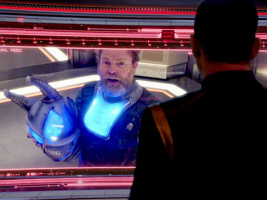
 Mudd in DIS: "Magic to Make the Sanest Man Go Mad"
Mudd in DIS: "Magic to Make the Sanest Man Go Mad"